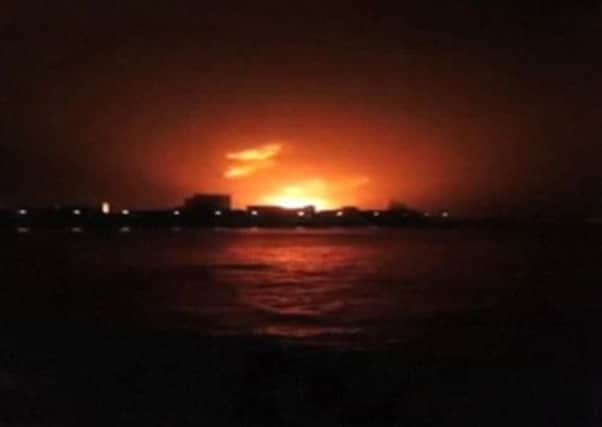Indian submarine explosion: 18 believed dead


Two blasts rocked the Indian navy sub INS Sindhurakshak as it was docked at India’s main naval base in Mumbai on Tuesday night.
The vessel, which later sank, was 16 years old and was Russian built.
Advertisement
Hide AdAdvertisement
Hide AdThe disaster came in the same week that India activated its first reactor on a nuclear submarine and launched an aircraft carrier, blighting a week of modernisation triumphs for the navy, including the launch of a locally built aircraft carrier aimed at giving India the edge at sea as it competes with China in the Indian Ocean.
Navy chief admiral DK Joshi said divers had managed to pry open the main hatch of the diesel-powered submarine, more than 12 hours after the incident, and were trying to find their way through the vessel.
“While we hope for the best, we are prepared for the worst … There is a possibility, however remote, of an air pocket. There is a possibility of someone having grabbed a breathing set,” he told a news conference.
The Sindhurakshak, which returned from an upgrade in Russia this year, had suffered an accident in 2010 in which one sailor was killed while it was docked in the southern port of Visakhapatnam. Usually, such a sub is fitted with torpedoes and missiles.
“Just short of midnight, there were two rapid and near- simultaneous major explosions on board the submarine, which resulted in a major and rapid spread of fire on board,” Joshi said. “It is some of the ordnance on board that seems to have exploded.”
A navy source said one or two men were usually on duty on top of a berthed submarine, and those stationed on the Sindhurakshak either jumped into the water or were thrown off by the force of the blast. The number of crew in the boat when fully operational is 110.
“A lot of things are in very close proximity, there is fuel, there is hydrogen, there is oxygen, there are weapons with high explosives on board,” said retired navy chief Arun Prakash.
“So a slightest mistake or slightest accident can trigger off a huge accident. The question of sabotage – I mean, all possibilities have to be considered – but sabotage is probably the last possibility.”
Advertisement
Hide AdAdvertisement
Hide AdAnother submarine in the Mumbai dock where vessels are usually tied to each other suffered minor damage, the naval source said.
The last big loss for the navy was the sinking of the INS Khukri frigate by a Pakistani navy torpedo during the 1971 war.
India’s navy has had far fewer accidents than the air force, which has been dogged for years by crashes of Russian-made MiG-21 fighters. However, most of the country’s fleet of 15 submarines is in urgent need of modernisation and has been hampered by delays in government procurement decisions as it battles corruption allegations.
Efforts to build a domestic arms industry to supply the military have made slow progress, with the country still the world’s largest importer.
This week, India’s first locally built aircraft carrier was launched, though it will not be fully operational until 2017.
The navy also announced this week that the reactor on its first indigenous nuclear submarine was operational as part of the plan to build a powerful navy to counter China’s growing presence in the Indian Ocean.
The Sindhurakshak completed a two-and-a-half year upgrade at a Russian shipyard a few months ago.
“This is a very, very old boat that really doesn’t go out on long sea patrols,” said Bharat Karnad, a senior fellow of national security studies, at the Centre for Policy Research.
Three people near the submarine at the time of the explosion were injured and were being treated in hospital, a navy spokesman said.